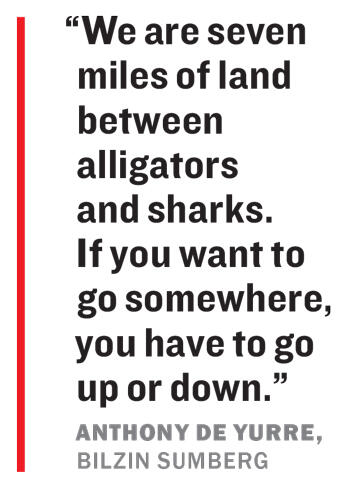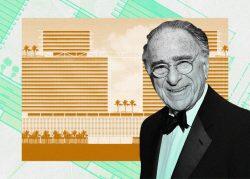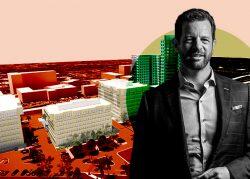Miami real estate development duo Jose Hevia and Stephen Blumenthal are not afraid of taking risks, let alone catching heat.
While developers’ proposals often anger residents who are fearful of traffic congestion and the loss of green space, Hevia and Blumenthal’s plan is so controversial, it’s on a scale that Miami-Dade County has not seen for almost a decade.
The partners envision an up to 9.2 million-square-foot industrial complex outside the Urban Development Boundary, an invisible line that restricts the sprawl of development as a way to preserve farms and wetlands surrounding the built-out part of Miami-Dade.
The greenbelt is vital to protecting the county from flooding, as well as for preservation and restoration of the Everglades, environmentalists say. They argue this is especially applicable to the land where Hevia and Blumenthal want to build their South Dade Logistics & Technology District.
Hevia, president of Miami-based Aligned Real Estate Holdings, and Blumenthal, principal of Coral Gables–based Coral Rock Development, pushed back on this claim, saying that the project is actually beneficial for the environment. Still, it is a hefty task to take on, Blumenthal conceded.
“Because of its size and because it involves moving the UDB, it is the most challenging deal that Coral Rock has developed,” he said. “I am in business to make a profit, so the reward will definitely outweigh our pursuit costs.”
Blumenthal and Hevia join a growing number of developers who have built some of the county’s marquee projects in prime locations — and are now homing in on the long-overlooked southern stretches of the county.
The area includes Homestead and Florida City, municipalities on the southernmost tip of Miami-Dade, and the neighborhoods of Naranja, Leisure City, Princeton and Goulds — largely single-family-home and townhouse communities interspersed among expansive, untapped land.
Therein lies the appeal to builders. South Miami-Dade is fertile ground for commercial real estate projects that would meet the growing rental and office demand, developers and brokers say. While prices of development sites in the urban core have reached new heights, south Miami-Dade is a reprieve.
Land sales in south Miami-Dade averaged about $795,000 per acre so far this year, a steal compared with the $22.9 million per acre in Miami’s core, roughly from Coconut Grove north to the Miami Design District, according to Colliers and CoStar Group data.
Lack of land has plagued Miami-Dade for decades because the county is sandwiched between the Everglades and Biscayne Bay.
“We are seven miles of land between alligators and sharks,” said Anthony De Yurre, a developers’ attorney with Bilzin Sumberg. “If you want to go somewhere, you have to go up or down.”
And many are going down. Way down south.
 Bitcoin bet
Bitcoin bet
Homestead, which was the second municipality in the county to incorporate in 1913, has a penchant for maintaining its independence from the rest of Miami-Dade.
Case in point: It has its own utility, unlike the rest of the county and even the state, which largely uses Florida Power & Light.
“That puts us in a unique position because we have been able to maintain our electric rates lower than most of the other parts of the state, which helps us attract more business,” said Homestead Vice Mayor Julio Guzman, who also is a realtor.
Entrepreneur Jose Mallea’s Esperanza Opportunity Zone Fund is in talks with the city to set up a Bitcoin mining business park that would tap into the city’s grid for the high-energy-consumption operation. Mallea is asking for a rate of 5.5 cents for every kilowatt-hour consumed.
“If we can attract one, we can attract 10,” Guzman said.
Homestead political winds have long swung in favor of development, with the city ready to shell out $71 million for a new sports complex south of the Homestead-Miami Speedway, according to Guzman. Homestead is pushing for a thriving west side, with grants averaging $25,000 for business facade improvements, interior buildout and expansion.
In downtown Homestead, the city completed Homestead Station near the bus corridor in 2019 with 30,800 square feet of retail, as well as a next-door ShowBiz Cinemas and Cybrarium library with offerings such as virtual reality.
In likely the biggest validation of Homestead’s efforts, Jorge Pérez’s Related Group wants to build an apartment and retail project on the southwest corner of Campbell Drive and U.S. 1. CityPlace Homestead, modeled after Related’s CityPlace Doral, started out as a proposal for over 300 apartments, but has expanded to 635 units, according to Guzman.
The development, which is still being negotiated, will likely be six or seven stories, although it could go slightly higher, Guzman said.
Rents are expected to be largely or entirely market rate, which in south Miami-Dade is lower than the skyrocketing rents fueled by population growth elsewhere in the county.
Homestead and its neighbors had the second-lowest monthly rents among nine county submarkets in the first quarter, at $1,637, much less than the $2,150 average countywide, according to a report from RealPage, provided by Newmark.
That is expected to attract more residents priced out of prime areas, experts say.
“Obviously, tenants from Miami who are local will move to other parts of the county that are more affordable because they understand the market a little better,” said Alexander Kaushansky of lender Arbor, which is making more south Miami-Dade loans.
As for the newcomers? “Not every single one of them can afford to live” in the urban core, he said. “So they are going to be moving to Homestead and Naranja.”
‘The Last of the Mohicans’
Across south Miami-Dade, 1,068 new apartments are expected to be completed this year, up from 88 in 2021, according to the RealPage report.
Additional proposals include Related Group’s plan for a 307-unit apartment complex with retail in seven low-rise buildings and an eight-story building, all on 10 acres in Princeton.
The site, on the west side of Southwest 127th Avenue and less than a quarter mile north of 248th Street, is in the Princeton Community Urban Center District. The county designated this Princeton area, as well as areas in Naranja, Perrine, Goulds and Leisure City, as urban districts, to allow for denser development. They are near the busway running along U.S. 1.
The districts were created years ago, but the market is at a tipping point, with developers taking a hard look at building garden-style communities in these areas, said De Yurre, the Bilzin attorney. It remains to be seen if mid-rise buildings will be feasible.
“I don’t know if they can build responsibly yet, because it’s a more expensive product,” he said. “Developers are sharpening their pencils and looking at where construction costs go, land costs go.”
The conundrum: Mid-rise buildings are more expensive to construct, partly because they require garages, which could run roughly $30,000 more per space than surface lots. Higher upfront costs means higher rents, but the south Miami-Dade resident is used to getting high-quality, new units at a significant discount, according to De Yurre.
Builders are considering using prefabricated walls, bathrooms and kitchens, a more efficient way to put projects together “like Legos,” he said.
The growth of the area around Dadeland Mall could also play a role in more renters moving to south Miami-Dade. “If demand continues the way it does, you are going to see a faster migration to a center of gravity with a nucleus of Dadeland,” De Yurre said.
Read more



Parts of south Miami-Dade are also Opportunity Zones, areas deemed in need of an economic boost. Under the Tax Cuts and Jobs Act of 2017, investors are incentivized to put their capital gains in Opportunity Zone real estate and business projects in exchange for tax breaks.
Critics of the law argue it used the 2010 Census to designate areas, resulting in the inclusion of already developed and gentrified areas.
South Miami-Dade Opportunity Zone investment could be more aligned with the law’s purpose. Yet, attorney Ronald Fieldstone, who represents Opportunity Zone investors, said the area is not yet a prime target. It’s still largely single-family houses, which don’t work for Opportunity Zones’ required long-term hold.
Developer Armando Bravo is not seeking Opportunity Zone funding for his 11 acres at 503 Krome Avenue, which he purchased for $5.4 million in October with plans for a supermarket.
The development-friendly city politics and low-priced land supply are enough of an incentive to bet on Homestead, he said.
“I want to call it the ‘Last of the Mohicans.’” Bravo said.
Everglades politics
The last time Miami-Dade expanded the Urban Development Boundary was to include 521 acres west of Doral in 2013.
Hevia and Blumenthal plan the South Dade Logistics project on 800 acres east and beyond the boundary. The land runs from the Florida Turnpike south to Southwest 268th Street and between Southwest 122nd and 107th avenues.
They separately own or have under contract a combined 335 acres slated for Phases I and II, Hevia said via email. The third phase on 329 acres is owned by others, and the remaining 130 acres are public and utility rights of way.
They laud the project as a much-needed boon for south Miami-Dade, promising the creation of 12,000 permanent jobs in an area where residents have a 30-mile drive to downtown Miami. Other employment hubs such as Kendall are roughly 20 miles away.
The largely industrial project would also have offices and retail and possibly a 150-key hotel, Blumenthal said. Not only is Miami-Dade’s industrial pipeline trailing that of other metropolises because of the scarcity of developable land, but a project of this scale is needed because the big-box users such as Target or Amazon need the accompanying smaller last-mile distribution facilities to be nearby, he added.
The proposed South Dade Logistics site is the only one that can accommodate a development of this scale, they said.
“We searched high and low, both Jose Hevia and myself,” Blumenthal said. “We were shown 15 acres here, 20 acres there. But a collective, contiguous piece of industrial property does not exist.”
Laura Reynolds, of the Hold The Line Coalition that fights UDB expansion, disagrees. “There are more areas for sale now than when they originally looked, but they should look again,” Reynolds said.
In fact, because Phase III landowners have not committed to the project, the first two phases can comfortably fit on a 400-acre site also in south Miami-Dade, but within the boundary, she said.
An entity owned by retired banker and environmental advocate Leonard Abess owns some of the land in the third phase, and asked the county in November to freeze its zoning application, citing concerns by state agencies reviewing the proposal.
Hold The Line’s concerns with South Dade Logistics include that the land is considered for Everglades and Biscayne Bay restoration, a government initiative to return the natural flow of the Everglades. Also, the wetlands on the site protect from storm surge, and the agricultural portion could prove to be vitally important for future farming needs, Reynolds said.
The developers’ plan is to raise the land by filling it in, but this would lead to flooding of the residential community to the west, she said.
Hevia and Blumenthal countered that the project would benefit the environment, as it will allow for Everglades discharges in the bay, but without the runoff from the farms on the site.
“Right now, there is tree farming and groves, and pesticides and fertilizers are all being used and dumped into Biscayne Bay,” Blumenthal said. “We are going to self-contain on the site, so there will be no runoff into the bay.”
Added Hevia: “The water quality improvements to Biscayne Bay will be realized with the South Dade Logistics & Technology District project much sooner than can ever be expected to occur through” the government’s restoration project.
The Miami-Dade County Commission is expected to take a final vote on the proposal this year, with the plan requiring nine out of the 13 commissioners to approve it. Mayor Daniella Levine Cava, who has opposed the plan, has veto power, although nine votes would be enough to override her.
The issue of balancing growth and environmental interests has been ever-present in other land-constrained markets, said Ken Johnson, a professor at Florida Atlantic University.
“This is a trade-off we have to decide as a society,” he said. “We might have to give up some environmental restrictions. And, well, we might want to maintain some environmental restrictions. Other places have dealt with this, but this is really going to come into focus in Southeast Florida.”
